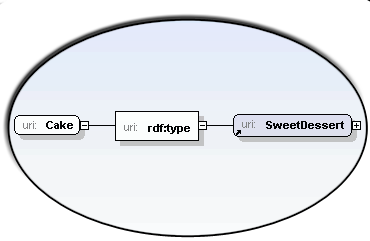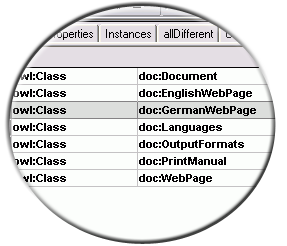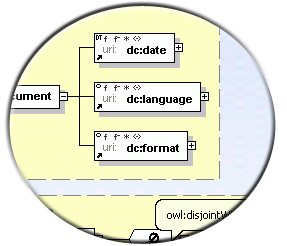Semantic Website Architecture
MICROSTRUCTURAL SEO
information hierarchy | descending heading titles | content sections | navigation
Semantic Architecture & Web Services: This page expands upon San Diego Web Design Studio's section on "Website Architecture", which addresses webpage hierarchy, navigational structure, intra-site linking methodologies, and categorization of topics and subjects.
For detailed information about Specific Uses, Semantic Web Languages and Dialects, formats, Ontology Web Languages, and Semantic Data Implementation and Referencing, and Demonstrational Examples, please see Microdata, Microformats, and Ontology Web Language, one of several semantically related sections on this website.
SEMANTIC BENEFITS TO WEB DESIGN & SEO CLIENTS
a. why bother with semantic integration? Well, from a web developer's perspective, the excitement doesn't stem from the notion of being replaced by machine language (lol...tongue firmly planted in cheek). But it does stem from the SEO rewards of feeding Google's appetite for more...more data...more micro-definitions...more info...more...more...more.
One thing seems obvious; Google can't seem to get enough in terms of unique content, new information, new ways of information dissection, and all the verbal crunching of an accounting with numbers and calculations. At the end of the day, it's bean counting or word dissection...
SAN DIEGO SEMANTIC SEO
The explosion of the Semantical Web has been fueled, in part, by competitive webmasters optimizing their sites to satisfy Google's enormous appetite for Microdata.
 San Diego Web Design Studio is on the cutting edge of next generation markup and optimization. Studying semantics and ontology web languages before it was a trendy, nerdy niche. Semantic optimization can encompass micro-seo quite macro-effectively. Our web services clients benefit by upgrading to Semantically optimized markup and language reference mapping for better search engine indexing, inclusion, and keyword query performance.
San Diego Web Design Studio is on the cutting edge of next generation markup and optimization. Studying semantics and ontology web languages before it was a trendy, nerdy niche. Semantic optimization can encompass micro-seo quite macro-effectively. Our web services clients benefit by upgrading to Semantically optimized markup and language reference mapping for better search engine indexing, inclusion, and keyword query performance.
Save time, resources, and money! Reach for extensible, w3c valid compliance. It's right thing to do...for our clients, for the web, and for our industry!
WHAT ARE SEMANTICS?
Semantics are: a form of linguistics based on word stemming. Google has been factoring semantic data into search algorithms for years. With the advent of Microformats, enhanced Html 5 properties, and more diversified CSS 3 selectors, classifying and micro tagging website content has become prolific and profitable as a means of onpage Search Optimization.
semantics (se·man·tics)
pronunciation: /si-'mant-iks/
definition: semantics
1. the scientific or philosophical study of the relations of words and their meanings.
2. the branch of linguistics that deals with the study of meaning, changes in meaning, and the principles that govern the relationship between sentences or words and their meanings.
METADATA AND SEMANTICS
b. Hasn't meta data been around a long time? Yes. Most web designers are familiar with terms such as "meta tags", "meta descriptions", "meta keywords", etc. Semantic Web Optimization takes the term "meta data" many steps further and more in-depth by identifying, classifying, and cross-referencing data within the content sections of the webpage. In addition, semantically cross-referenced "RDF", the acronym for "Resource Description Framework" information is also micro-specified in the header section of the webpage, yet much more intricately than the "meta data" of Web 1.0 and Web 2.0.
With external link references to Custom Vocabularies that further define the tags and classes used to micro-specify items such as "author", "content", "relationship", "date published", as well as geographical specifications, and more.
WEB 3.0
c. the semantic web: web 3.0, pronounced "web three point oh", is being referred to as the "semantic web" by the web industry. Whereas web 1.0 was basically reading and writing online with very limited interactivity, web 2.0 introduced the advent of Social Media, and was therefore dubbed the "collaborative web". Web 3.0 had been referred to as the next version for some time, vaguely and futuristically, but only recently was themed semantical in nature.
POPULAR SEMANTIC DIALECTS
d. semantic languages in use: although it is outside the scope of this document to define and explain the various languages and custom vocabulary options gaining ground in the semantical race, san diego web design studio hosts a section explaining semantic libraries and languages in detail, the following list itemizes just a few of the growing list of various "languages" in use for semantically referencing relationships among words, meanings, and data:
rdf: resource description framework
e. rdfa | rdf: Of the most prolific vocabularies and language types, both Microformats, or RDFa, which differs slightly from RDF (no a), and Geo XML, are growing rapidly in popularity and becoming widely accepted. Neither of these languages have seen their way to becoming "web standards", as the recommendation process with the W3C is so lengthy and analytically thorough in nature.

rdf vocabularies & semantic languages
f. a data reference overview: although it is outside the scope of this document to define and explain the various languages and custom vocabulary options gaining ground in the semantical race, san diego web design studio hosts a section explaining semantic libraries and languages in detail
microformats:
g. contact cards | recipes | reviews | calendars: microformats.org is a grass roots organization of web authors and developers who have grown impatient with the web standardization process for semantic webpage markup. The Microformats.org syntax began with hCards and vCards, written in a format that is compatible with Microsoft Outlook, Mobile Phone Software, and other eMail and Phone Contact databases. Information programmed with Microformats can be downloaded seamlessly into eMail clients and scheduling software. The following link provides the option to view and download San Diego Web Studio's vCard.
microformats:
semantic metadata & microdata:
 h. custom vocabulary options vs. dublin core, etc:
Semantical markup takes the meta data of web 1.0 and 2.0, very basic in nature, and enhances web authors capabilities by allowing the creation and reference to custom vocabularies. for instance, one of our clients might have carved out a professional niche in "Jury Selection" services that she markets to other criminal defense attorneys who are taking high risk cases to trial. This client might have in-depth experience not only in criminal defense, but may specialize in DNA research and laboratory specimen contamination. Therefore, she may use a bacterial or chemical vocabulary that is very unique in nature. For this client, we could establish the custom vocabulary based on her highly specialized keywords and topics.
h. custom vocabulary options vs. dublin core, etc:
Semantical markup takes the meta data of web 1.0 and 2.0, very basic in nature, and enhances web authors capabilities by allowing the creation and reference to custom vocabularies. for instance, one of our clients might have carved out a professional niche in "Jury Selection" services that she markets to other criminal defense attorneys who are taking high risk cases to trial. This client might have in-depth experience not only in criminal defense, but may specialize in DNA research and laboratory specimen contamination. Therefore, she may use a bacterial or chemical vocabulary that is very unique in nature. For this client, we could establish the custom vocabulary based on her highly specialized keywords and topics.
specifying the vocabulary definitions referenced:
i.a referencing vocabulary definitions externally: Thus, when we reference RDF, or framework, in the header of the web page, we link externally to that vocabulary to assist search engines and artificial intelligence robots in further defining and categorizing our client's services. This data is then translated into "machine language". This automation is the type of information Google loves. It is also, sadly, the beginning of the end of a human controlled internet. Future languages of the web will no longer be solely reliant on what web authors and bloggers post. It will generate its own content based on pre-programmed understanding of these XML based languages of the future. Huge databases will chew up and spit out data that far surpasses what non-machinated input can provide.
borrowing classifications from established vocabularies:
 j. dublin core | dc: One popular vocabulary often referenced externally from the header section of semantically optimized webpages is the Dublin Core, one of the oldest and most comprehensive general vocabularies online. Not all clients or websites necessitate custom vocabulary creation, and semantically reference can be as generic as specifying "date of publication", "author", "industry", (i.e, computers and internet), "relationships" ("foaf", for example...acronym for "friend of a friend", and currently in use by social media software), and more.
j. dublin core | dc: One popular vocabulary often referenced externally from the header section of semantically optimized webpages is the Dublin Core, one of the oldest and most comprehensive general vocabularies online. Not all clients or websites necessitate custom vocabulary creation, and semantically reference can be as generic as specifying "date of publication", "author", "industry", (i.e, computers and internet), "relationships" ("foaf", for example...acronym for "friend of a friend", and currently in use by social media software), and more.
any drawbacks to semantic markup?
k. worst case scenario for semantic tagging: Extra markup seems to be one of the only downsides to semantically classifying web content. But what is a few extra tags if they make Google happy? The trend toward semantical markup far outweighs a bit more complexity in the website's tags...Google is encouraging [ultimately driving the web toward] Ontology Web Language [OWL]), Reference Definition Framework [RDF], Microformats [RDFa], Extensible Markup Language [XML], and Custom Vocabularies. Machine Language means the web running the web...or Google running the web even more so?.
cross-check: validate per w3c:
l. validate to correct errors & ensure compliance: Obviously, as wiith any webpage construction and/or authoring, the possibility of human error exists. Incorrect, spammy, and / or inappropriate semantic markup runs the risk of creating seo penalties by Google's algorithmic formulas. This is nothing new, and why experienced webmasters advise "validate, validate, and validate again"...per the W3C Valid Markup Tool and Semantic Data Extractor, at the very least.
semantic seo services
* Please Note: Semantic Markup is an advanced onpage Seo service. It is an add-on service for for san diego web design & Seo clients. Please request a semantic consultation if you are unsure semantics will benefit your business. For specific terms regarding your web design project in progress, or post launch, please refer to the custom proposal and website design agreement defining the in-scope features requested. Please feel free to call 619.504.0450 anytime, for any reason. san diego web design studio is always happy to help ... sweet
"the web isn't merely words ¯ it's information about things in the real world, and understanding the relationships between real-world entities can help us deliver relevant information more quickly. … With efforts like rich snippets and the search answers feature, we're just beginning to apply our understanding of the web to make search better... and we've acquired Metaweb because we believe working together we'll be able to provide better answers." Google also recently purchased Freebase.com
Google's Official Blog Announcement, July 16th, 2010
ready to scoot?
Let's make your site swift...make it scoot...make it smooth.
Page performance is a controllable factor...in contrast to what your competitors do, which is not within our control [damn it...we'll keep trying, though]. From an SEO and website usability standpoint, website performance is a great investment. So if Ready for your site to beat it? Call us and discuss. 619.504.0450.


 Website Development Intro
Website Development Intro



